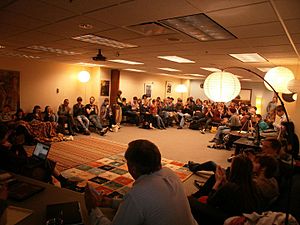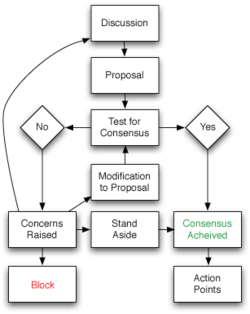Consensus facts for kids

Consensus decision-making is a group decision-making process in which group members develop, and agree to support a decision in the best interest of the whole. Consensus may be defined professionally as an acceptable resolution, one that can be supported, even if not the "favourite" of each individual. Consensus is defined by Merriam-Webster as, first, general agreement, and second, group solidarity of belief or sentiment. It has its origin in the Latin word cōnsēnsus (agreement), which is from cōnsentiō meaning literally feel together. It is used to describe both the decision and the process of reaching a decision. Consensus decision-making is thus concerned with the process of deliberating and finalizing a decision, and the social, economic, legal, environmental and political effects of using this process.
Contents
Objectives
As a decision-making process, consensus decision-making aims to be:
- Agreement Seeking: A consensus decision making process attempts to generate as much agreement as possible.
- Collaborative: Participants contribute to a shared proposal and shape it into a decision that meets the concerns of all group members as much as possible.
- Cooperative: Participants in an effective consensus process should strive to reach the best possible decision for the group and all of its members, rather than competing for personal preferences.
- Egalitarian: All members of a consensus decision-making body should be afforded, as much as possible, equal input into the process. All members have the opportunity to present, and amend proposals.
- Inclusive: As many stakeholders as possible should be involved in the consensus decision-making process.
- Participatory: The consensus process should actively solicit the input and participation of all decision-makers.
Alternative to common decision-making practices
Consensus decision-making is an alternative to commonly practiced group decision-making processes. Robert's Rules of Order, for instance, is a guide book used by many organizations. This book allows the structuring of debate and passage of proposals that can be approved through majority vote. It does not emphasize the goal of full agreement. Critics of such a process believe that it can involve adversarial debate and the formation of competing factions. These dynamics may harm group member relationships and undermine the ability of a group to cooperatively implement a contentious decision. Consensus decision-making attempts to address the beliefs of such problems. Proponents claim that outcomes of the consensus process include:
- Better decisions: Through including the input of all stakeholders the resulting proposals may better address all potential concerns.
- Better implementation: A process that includes and respects all parties, and generates as much agreement as possible sets the stage for greater cooperation in implementing the resulting decisions.
- Better group relationships: A cooperative, collaborative group atmosphere can foster greater group cohesion and interpersonal connection.
Decision rules
The level of agreement necessary to finalize a decision is known as a decision rule. Possible decision rules for consensus vary within the following range:
- Unanimous agreement
- Unanimous consent (See agreement vs consent below)
- Unanimous agreement minus one vote or two votes
- Unanimous consent minus one vote or two votes
- Super majority thresholds (90%, 80%, 75%, two-thirds, and 60% are common).
- Simple majority
- Executive committee decides
- Person-in-charge decides
In groups that require unanimous agreement or consent (unanimity) to approve group decisions, if any participant objects, they can block consensus according to the guidelines described below. These groups use the term consensus to denote both the discussion process and the decision rule. Other groups use a consensus process to generate as much agreement as possible, but allow participants to finalize decisions with a decision rule that does not require unanimity. In this case, someone who has a strong objection must live with the decision.
Related pages
Images for kids
-
A general assembly at Occupy Wall Street (2011) where people aimed to establish consensus.
See also
 In Spanish: Consenso para niños
In Spanish: Consenso para niños





